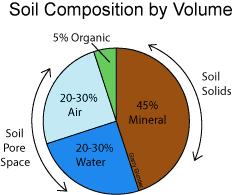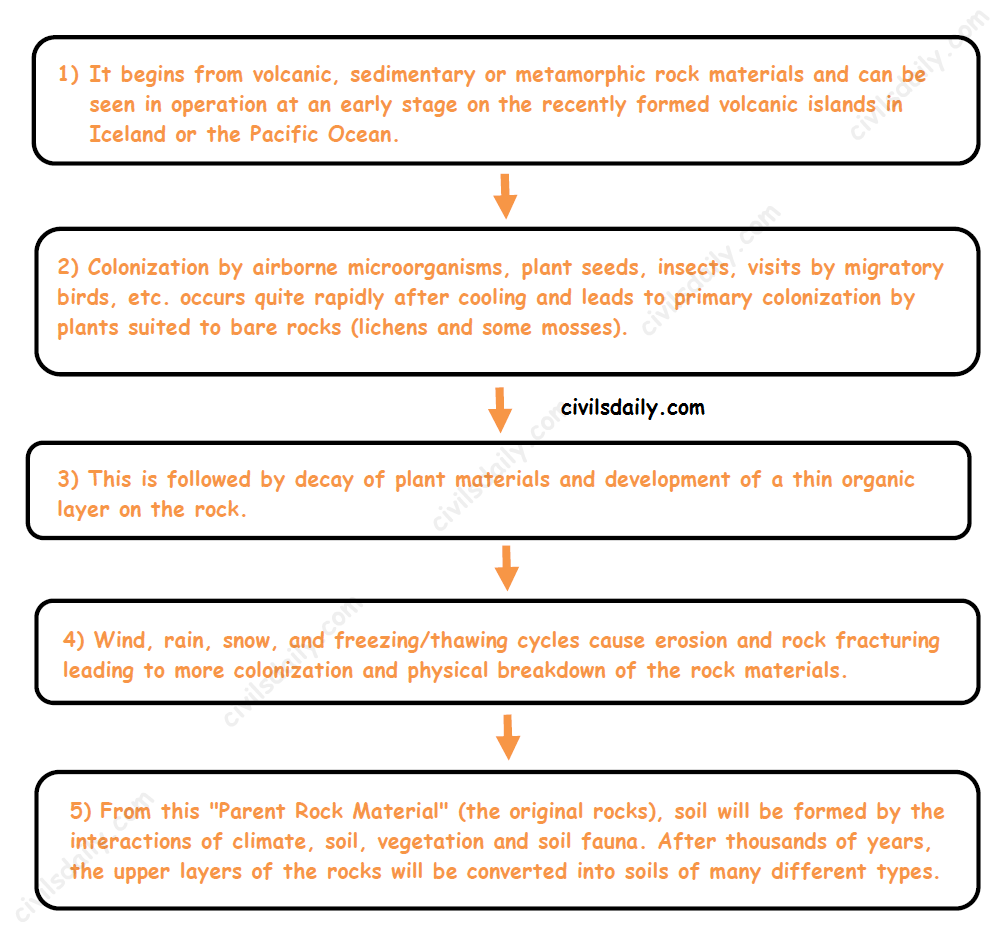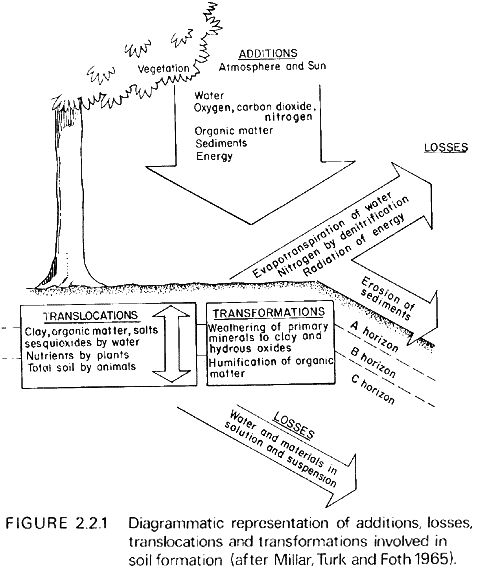Before we discuss the various soil types and their distribution in India, it is imperative that we first go through the basics. Let’s begin with what soil is and how it is formed:
What is soil?
Soil is the loose material of the earth’s surface in which the terrestrial plants grow. It is usually formed from weathered rock or regolith changed by chemical, physical and biological process.
Thus the soil may be considered as an entity, quite apart from the rocks below it. It consists partly of mineral particles and partly, to a varying extent, of organic matter. Let’s look at the composition in detail:
Composition of soils:
Soils have four main constituents:
- Mineral matter – It includes all minerals inherited from the parent material as well as those formed by recombination from substances in the soil solution.
- Organic matter – It is derived mostly from decaying plant material broken down and decomposed by the actions of animals and microorganisms living in the soil. It is this organic portion that differentiates soil from geological material occurring below the earth’s surface which otherwise may have many of the properties of a soil. (Note: The end product of breakdown of dead organic material is called humus.)
- Air
- Water
Normally, both air and water fill the voids in soil. Air and water in the soil have a reciprocal relationship since both compete for the same pore spaces.
For example, after a rain or if the soil is poorly drained, the pores are filled with water and air is excluded. Conversely, as water moves out of a moist soil, the pore space is filled with air. Thus the relationship between air and water in soils is continually changing.
The ratio of the components by volume is generically indicated as:
 Source
Source
Note: The exact ratio depends on various factors like geographical location and the historical treatment of soil – by humans, by climate, by time.
Why is soil so important?
Soils are essential for life, in the sense that they provide the medium for plant growth, habitat for many insects and other organisms, act as a filtration system for surface water, carbon store and maintenance of atmospheric gases. They also support buildings and highways and contribute to the economies of our cities.
E.g. the rich, deep fertile soils of the Ganga plain especially its delta and the coastal plains of Kerala support a high density of population through agricultural prosperity. On the other hand, the shallow and coarse-grained soils of Telangana and Rajasthan do not provide a base for prosperous agriculture and thus support only a small population.
At the same time, the soil must not be regarded as a passive and inert body on the earth’s surface. It is a continually changing system within the total environment. The nature of a soil reflects the ancient environments under which it formed as well as current environmental conditions. The soil forming process, also known as pedogenesis, is described below:
How is soil formed?
Soil formation is a process taking many thousands of years.

The Pedogenic Processes:
The above-explained conversion from rocks to soils happens via four basic processes:
- Additions
- Losses
- Translocations
- Transformations
Let’s look at these soil forming processes in detail:
- Additions: Most additions occur at the surface. The most obvious ones include solar energy, water controlled by climate, and organic material derived principally from the vegetation.
- Losses: Losses occur both from the surface and from the deep subsoil. For instance, water is lost by evapotranspiration and carbon dioxide by diffusion at the surface and, on a more catastrophic level, large masses of soil can be stripped by erosion. Materials suspended or dissolved in water are the main forms of losses from the subsoil e.g. leaching.
- Translocation: It refers to the physical movement of material within the soil. The material can be in the solid, liquid or gaseous form, the movement can be in any direction from and to any horizon. For instance clay, organic matter and iron and aluminium hydrous oxides are commonly moved from the surface horizon to a subsurface horizon. Conversely, in very dry climates salts are moved upwards in solution by capillarity, and in very cold climates solid mineral fragments are moved upwards by frost action.
- Transformation: Additions, losses and translocations all involve movement as shown in the above figure. Transformations, on the other hand, involve the change of some soil constituent without any physical displacement. Chemical and physical weathering and the decomposition of organic matter are included here.
Source
All these processes occur to a greater or lesser extent in all soils. The properties that characterise one soil are the result of a particular balance among all the processes. Other soils will be different because they have been formed by groups of processes having different balances.
- The two driving forces for these processes are:
- climate (temperature and precipitation), and
- organisms, (plants and animals).
- Passive factors:
- Parent material is usually a rather passive factor in affecting soil processes because parent materials are inherited from the geologic world.
- Topography (or relief) is also rather passive in affecting soil processes, mainly modifying the climatic influences of temperature and precipitation.



